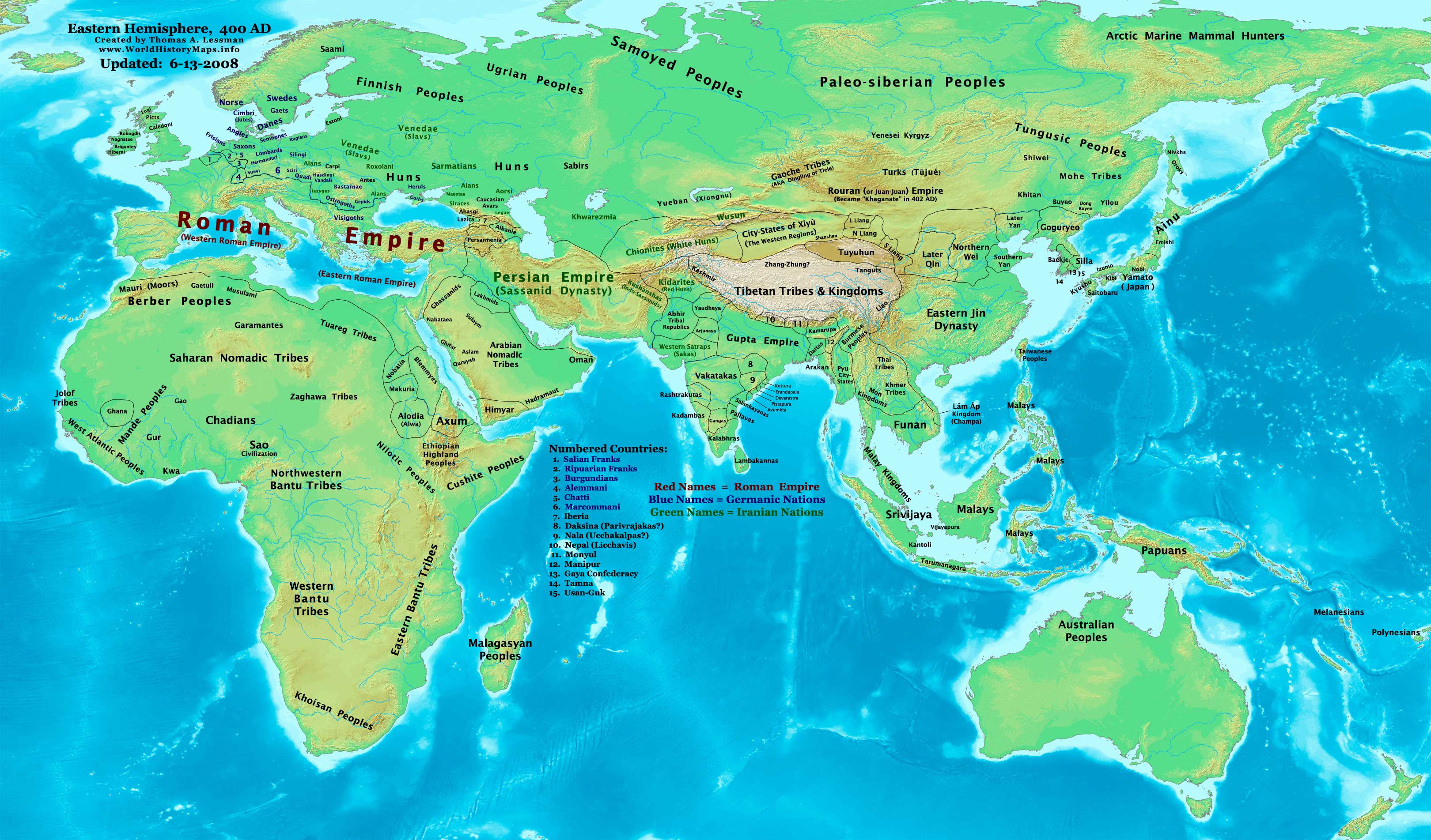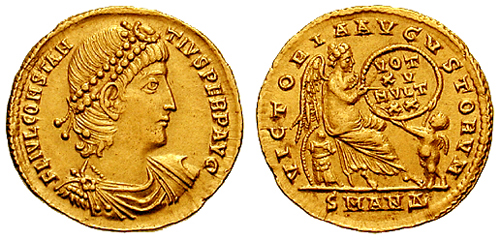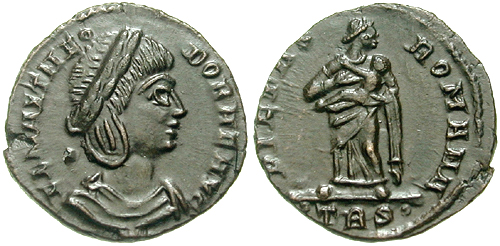|
Daughter Of Julius Constantius
A daughter of Julius Constantius and Galla, of unknown name, was Roman empress as the first wife of Constantius II. Family She is mentioned in the "Letter To The Senate And People of Athens" by Emperor Julian to have been a sister of Constantius Gallus. When mentioning the execution of Gallus by orders of Constantius II, Julian lists the several ways the two men were related. "Constantius gave over to his most inveterate enemies, his own cousin, the Caesar, his sister's husband, the father of his niece, the man whose own sister he had himself married in earlier days". Gallus was a son of Julius Constantius and his first wife Galla. She is assumed to be a full sister of Gallus. Julius Constantius was a son of Constantius Chlorus and Flavia Maximiana Theodora. He was a paternal half-brother of Constantine I. Constantine died in 337 and several of his relatives were killed shortly thereafter, including Julius Constantius. The event is reported in the "History of the Arians" (358 ... [...More Info...] [...Related Items...] OR: [Wikipedia] [Google] [Baidu] |
List Of Roman Empresses
The term Roman empress usually refers to the consorts of the Roman emperors, the rulers of the Roman Empire. The duties, power and influence of empresses varied depending on the time period, contemporary politics and the personalities of their husband and themselves. Empresses were typically highly regarded and respected, and many wielded great influence over imperial affairs. Several empresses served as Regent, regents on behalf of their husbands or sons and a handful ruled as empresses regnant, governing in their own right without a husband. Given that there were sometimes more than one concurrent Roman emperor, there were also sometimes two or more concurrent Roman empresses. For most of the period from 286 to 480, the Roman Empire, though remaining a single polity, was administratively divided into the Western Roman Empire and the Eastern Roman Empire. Through most of this period, the separated imperial courts had their own lines of succession, and as a result their own sequen ... [...More Info...] [...Related Items...] OR: [Wikipedia] [Google] [Baidu] |
Flavia Maximiana Theodora
Flavia Maximiana Theodora (died before 337) was a Roman empress as the wife of Constantius Chlorus. Biography Early life She is often referred to as a stepdaughter of Emperor Maximian by ancient sources, leading to claims by historians Otto Seeck and Ernest Stein that she was born from an earlier marriage between Eutropia, wife of Maximian, and Afranius Hannibalianus. This man was consul in 292 and praetorian prefect under Diocletian. Timothy Barnes challenges this view, arguing that all "stepdaughter sources" derive their information from the hypothetical 4th century '' Enmannsche Kaisergeschichte'', which Barnes considers unreliable, while sources he considers to be more reliable refer to Theodora as Maximian's daughter, rather than his stepdaughter. He concludes that she was born to an earlier wife of Maximian, possibly one of Hannibalianus's daughters. Although Julia Hillner agreed with the idea of Theodora being Maximian's biological daughter, she also observed that Barn ... [...More Info...] [...Related Items...] OR: [Wikipedia] [Google] [Baidu] |
4th-century Roman Empresses
The 4th century was the time period from 301 CE (represented by the Roman numerals CCCI) to 400 CE (CD) in accordance with the Julian calendar. In the West, the early part of the century was shaped by Constantine the Great, who became the first Roman emperor to adopt Christianity. Gaining sole reign of the empire, he is also noted for re-establishing a single imperial capital, choosing the site of ancient Byzantium in 330 (over the current capitals, which had effectively been changed by Diocletian's reforms to Milan in the West, and Nicomedeia in the East) to build the city soon called Nova Roma (New Rome); it was later renamed Constantinople in his honor. The last emperor to control both the eastern and western halves of the empire was Theodosius I. As the century progressed after his death, it became increasingly apparent that the empire had changed in many ways since the time of Augustus. The two-emperor system originally established by Diocletian in the previous century fel ... [...More Info...] [...Related Items...] OR: [Wikipedia] [Google] [Baidu] |
350s Deaths
35 or XXXV may refer to: * 35 (number) * 35 BC * AD 35 * 1935 * 2035 Science * Bromine, a halogen in the periodic table * 35 Leukothea, an asteroid in the asteroid belt Music * ''XXXV'' (album), a 2002 album by Fairport Convention * ''35xxxv'', a 2015 album by One Ok Rock * "35" (song), a 2021 song by New Zealand youth choir Ka Hao * "Thirty Five", a song by Karma to Burn from the album ''Almost Heathen'', 2001 * III-V Semiconductor materials are nominally small band gap insulators. The defining property of a semiconductor material is that it can be compromised by doping it with impurities that alter its electronic properties in a controllable way. Because of ..., a type of semiconductor material Other uses * ''35'' (film), an Indian Telugu-language drama film {{Numberdis ... [...More Info...] [...Related Items...] OR: [Wikipedia] [Google] [Baidu] |
4th-century Births
The 4th century was the time period from 301 CE (represented by the Roman numerals CCCI) to 400 CE (CD) in accordance with the Julian calendar. In the West, the early part of the century was shaped by Constantine the Great, who became the first Roman emperor to adopt Christianity. Gaining sole reign of the empire, he is also noted for re-establishing a single imperial capital, choosing the site of ancient Byzantium in 330 (over the current capitals, which had effectively been changed by Diocletian's reforms to Milan in the West, and Nicomedeia in the East) to build the city soon called Nova Roma (New Rome); it was later renamed Constantinople in his honor. The last emperor to control both the eastern and western halves of the empire was Theodosius I. As the century progressed after his death, it became increasingly apparent that the empire had changed in many ways since the time of Augustus. The two-emperor system originally established by Diocletian in the previous century fel ... [...More Info...] [...Related Items...] OR: [Wikipedia] [Google] [Baidu] |
Magnentius
Magnus Magnentius ( 303 – 10 August 353) was a Roman general and usurper against Constantius II. Of Germanic descent, Magnentius served with distinction in Gaul, where the army chose him as a replacement for the unpopular emperor Constans. Acclaimed ''Augustus'' on 18 January 350, Magnentius quickly killed Constans and gained control over most of the Western Empire. The Eastern emperor Constantius II, brother of Constans, refused to acknowledge Magnentius's legitimacy, leading to three years of civil war. Decisively defeated at the Battle of Mons Seleucus, Magnentius killed himself on 10 August 353. Much of Magnentius's short reign was concerned with asserting his legitimacy. Unlike Constans, Magnentius was unrelated to Constantine the Great, and so had no dynastic claim to the emperorship. Magnentius instead sought popular support by modeling himself as a liberator who had freed the Western Empire from the tyranny of Constans. He attempted various public and religious refor ... [...More Info...] [...Related Items...] OR: [Wikipedia] [Google] [Baidu] |
Eusebia (empress)
Eusebia (Greek: Εύσεβία, died before 361) was Roman empress as the second wife of Roman emperor Constantius II. The main sources for the knowledge about her life are Julian's panegyric "Speech of Thanks to the Empress Eusebia", as well as several remarks by the historian Ammianus Marcellinus. Family Julian's "Panegyric In Honour Of Eusebia", the primary source for her family and ancestry, states that "she is of a family line that is pure Greek, from the purest of Greeks, and her city is the metropolis of Macedonia". Her father was the first member of the family to serve as a consul. The Panegyric never gives his name, but modern historians identify him with Flavius Eusebius, consul in 347. This Eusebius is identified elsewhere as a former Magister Equitum and Magister Peditum, which means he had served as a military commander of both the cavalry and infantry of the Roman army. The Prosopography of the Later Roman Empire considers it probable that his consulship came ... [...More Info...] [...Related Items...] OR: [Wikipedia] [Google] [Baidu] |
Eusebius Of Caesarea
Eusebius of Caesarea (30 May AD 339), also known as Eusebius Pamphilius, was a historian of Christianity, exegete, and Christian polemicist from the Roman province of Syria Palaestina. In about AD 314 he became the bishop of Caesarea Maritima. Together with Pamphilus, Eusebius was a scholar of the biblical canon and is regarded as one of the most learned Christians during late antiquity. He wrote the ''Demonstrations of the Gospel'', '' Preparations for the Gospel'' and ''On Discrepancies between the Gospels'', studies of the biblical text. His work '' Onomasticon'' is an early geographical lexicon of places in the Holy Land mentioned in the Bible. As "Father of Church History" (not to be confused with the title of Church Father), he produced the ''Ecclesiastical History'', ''On the Life of Pamphilus'', the ''Chronicle'' and ''On the Martyrs''. He also produced a biographical work on Constantine the Great, the first Christian Roman emperor, who was ''Augustus'' between A ... [...More Info...] [...Related Items...] OR: [Wikipedia] [Google] [Baidu] |
Athanasius Of Alexandria
Athanasius I of Alexandria ( – 2 May 373), also called Athanasius the Great, Athanasius the Confessor, or, among Coptic Christians, Athanasius the Apostolic, was a Christian theologian and the 20th patriarch of Alexandria (as Athanasius I). His intermittent episcopacy spanned 45 years ( – 2 May 373), of which over 17 encompassed five exiles, when he was replaced on the order of four different Roman emperors. Athanasius was a Church Father, the chief proponent of Trinitarianism against Arianism, and a noted Egyptian Christian leader of the fourth century. Conflict with Arius and Arianism, as well as with successive Roman emperors, shaped Athanasius' career. In 325, at age 27, Athanasius began his leading role against the Arians as a deacon and assistant to Bishop Alexander of Alexandria during the First Council of Nicaea. Roman Emperor Constantine the Great had convened the council in May–August 325 to address the Arian position that the Son of God, Jesus of N ... [...More Info...] [...Related Items...] OR: [Wikipedia] [Google] [Baidu] |
Constantine I
Constantine I (27 February 27222 May 337), also known as Constantine the Great, was a Roman emperor from AD 306 to 337 and the first Roman emperor to convert to Christianity. He played a Constantine the Great and Christianity, pivotal role in elevating the status of Christianity in Rome, Edict of Milan, decriminalising Christian practice and ceasing Persecution of Christians in the Roman Empire, Christian persecution. This was a turning point in the Historiography of the Christianization of the Roman Empire, Christianisation of the Roman Empire. He founded the city of Constantinople (modern-day Istanbul) and made it the capital of the Empire, which it remained for over a millennium. Born in Naissus, a city located in the Roman province, province of Moesia Superior (now Niš, Serbia), Constantine was the son of Flavius Constantius, a Roman army officer from Moesia Superior, who would become one of the four emperors of the Tetrarchy. His mother, Helena, mother of Constantin ... [...More Info...] [...Related Items...] OR: [Wikipedia] [Google] [Baidu] |
Constantius Chlorus
Flavius Valerius Constantius ( – 25 July 306), also called Constantius I, was a Roman emperor from 305 to 306. He was one of the four original members of the Tetrarchy established by Diocletian, first serving as Caesar (title), ''caesar'' from 293 to 305 and then ruling as Augustus (title), ''augustus'' until his death. Constantius was also father of Constantine the Great, the first Christian emperor of Rome. The nickname "Chlorus" () was first popularized by Byzantine Empire, Byzantine-era historians and not used during the emperor's lifetime. As an Illyrian emperors, Illyrian soldier of humble origin, Constantius had a distinguished military career and rose to the top ranks of the army. Around 289, he set aside Helena (mother of Constantine), Helena, Constantine's mother, to marry a daughter of Emperor Maximian, and in 293 was added to the imperial college by Maximian's colleague Diocletian. Assigned to rule Roman Gaul, Gaul, Constantius defeated the usurper Carausius th ... [...More Info...] [...Related Items...] OR: [Wikipedia] [Google] [Baidu] |






